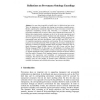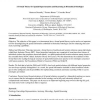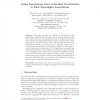2093 search results - page 71 / 419 » Developing Federation Object Models Using Ontologies |
IPAW
2010
13 years 5 months ago
2010
As more data (especially scientific data) is digitized and put on the Web, the importance of tracking and sharing its provenance metadata grows. Besides capturing the annotation pr...
KDD
2004
ACM
14 years 8 months ago
2004
ACM
Traditional clustering is a descriptive task that seeks to identify homogeneous groups of objects based on the values of their attributes. While domain knowledge is always the bes...
ARTMED
2006
13 years 7 months ago
2006
Objective: The objective of this paper is to demonstrate how a formal spatial theory can be used as an important tool for disambiguating the spatial information embodied in biomed...
MODELLIERUNG
2004
13 years 9 months ago
2004
ion from the implementation they use. Some tools rather consequently use this abstract model; others at least partly keep the implementational view, modeling components, e.g., by o...
DILS
2007
Springer
14 years 1 months ago
2007
Springer
This paper presents the LSLink (or Life Science Link) methodology that provides users with a set of tools to explore the rich Web of interconnected and annotated objects in multipl...



